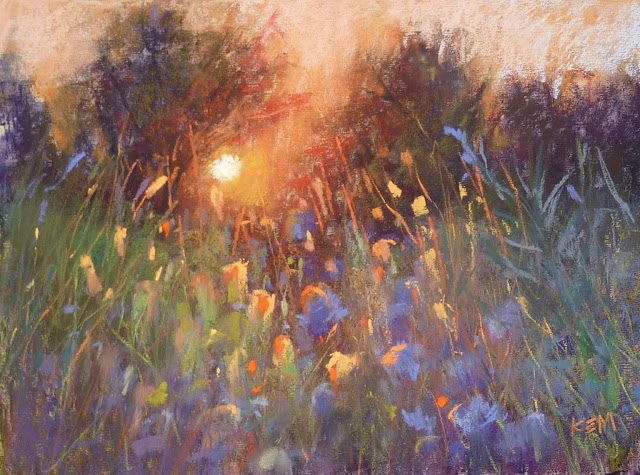Ahhhh the smell of oil paint and Gamsol filled my studio today. It made it feel like a real art studio somehow. Pastel is an odorless medium and I forget how much I love the smell of paint. I took the oils out this month to share the technique with my Patreon group.
I love to experiment and change things up! Different papers, different pastels and different underpainting techniques are all things I look to try. This month I decided to do an oil stain underpainting. It has been awhile since I have used this technique but I do love it. Read on for some tips on making the best of this technique.
 |
| Tools of the trade |
SUPPLIES NEEDED
- Paint: a few tubes of oil paint. I only use alizarin crimson, ultramarine blue and cadmium yellow medium and mix the colors I need. I don't use white since I want my colors to be rich and transparent. I don't use black either but mix red and blue for a nice rich dark.
- Brush: I use a cheap bristle brush because I like to scrub the paint and the sanded papers are hard on a brush!
- OMS: which stands for odorless mineral spirits. You can use your preferred brand. I use Gamsol or Turpenoid. Do not use the Turpenoid in the green can. In my experience it doesn't dry as well especially if you use it to do a wash with pastels. You will also need a can or jar for the OMS.
- Paper: You need a pastel paper or board that can get wet. I prefer Uart paper. Ampersand Pastelbords are an excellent choice as well. For today's painting I used Pastelmat which wasn't my favorite choice. I didn't get the drips I usually get with Uart paper.
 |
| closeup of the oils stain |
I love the vibrancy of the oil paint. It makes a rich and colorful underpainting. The trick is getting the paint the right consistency. I call it an Oil Stain because you want to get the paint the consistency of wood stain. I use the OMS liberally when mixing my paint and make a puddle of color the consistency of stain or tea. If it is too thick the painting will fill the tooth of the paper and you won't be able to layer much pastel. If it is too wet it will just run and it won't stain the paper.
TIP: If you can see brush marks in the paint then it is too thick....thin it with more OMS. Practice, practice and more practice will allow you to know just how much OMS is enough.
As the paint dries the magic begins. The best underpaintings will result in interesting drips that look like root systems. The Pastelmat absorbed the paint so quickly that it didn't drip. It was a bit disappointing but I still loved the vibrancy of the oil paint and it gave me something colorful to respond to.
The painting in today's post is the Paint Along demo this month for my Patreon group. Paint along with me! www.patreon.com/karenmargulis


1 comment:
I am concerned if you use oil mediums of any kind directly on paper, wood, canvas, etc. The caustic oils will eat the paper (or canvas, etc) over time, destroying it. That is why a buffer medium is used as a ground to prime and protect the underlying substrate, such as gesso, rabbit skin glue, etc. I'm sure you probably already know that, and I may have missed if you used a layer of clear gesso or something to protect the underlying pastelmat. I assume you don't want the painting to rapidly self destruct over the years. I'm not aware of pastelmat having a PH buffered layer already to protect it from oil mediums soaking into it. I'm happy to stand corrected if I'm wrong! I know people use oil pastels on various media without priming it but I have also seen many such paintings sadly deteriorate.
Post a Comment